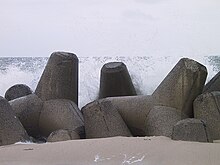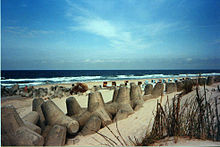Tetrapod (stone)
Tetrapods ( Greek τετραπόδης tetrapódēs , German 'four feet ' ) are concrete blocks that are used in coastal protection structures . The “arms” of the roughly six-ton stones are aligned with the corners of an imaginary tetrahedron . Tetrapods are strung together on the coastline , on dams or harbor moles or stacked in several rows. They serve primarily as breakwaters and are intended to reduce the force of the water waves that hit the bank .
history
The invention of the tetrapods goes back to the French laboratory Établissements Neyrpic in Grenoble . From 1950 the tetrapods were patented for Neyrpic in many countries.
Manufacturing
The production of tetrapods is simple and is usually carried out directly at the intended place of use because of the more cost-effective transport of liquid concrete: A reusable hollow mold made of steel is poured from above with seawater-resistant concrete. After this has hardened, it is opened on the outside and the finished tetrapod is lifted to its final location by a crane. Floating cranes are often used in port construction .
Applications
Tetrapods are also used to fortify banks in river engineering . They offer the advantage that numerous cavities are created as a retreat for fish and other aquatic animals. They have also proven themselves in the construction of guide dams or port fortifications on solid ground.
Research projects
The Alfred Wegener Institute (AWI) started a project in 2009 to research what effects the tetrapods on the German North Sea coast have on the natural development of coastal structures. In particular, the researchers want to find out how the tetrapods affect salt marshes and tidal flats .
Military use as an anti-tank barrier
Tetrapods have also been used as anti-tank barriers .
See also
Web links
supporting documents
- ↑ Contribution by Charles E. Lee (English)
- ^ JE Kaufmann, HW Kaufmann: The Atlantic Wall: History and Guide.
- ↑ Military monuments in the cantons of Glarus, Appenzell Inner- and Ausserrhoden and St. Gallen: Inventory of combat and command structures. ( Memento of the original from April 16, 2014 in the Internet Archive ) Info: The archive link was inserted automatically and has not yet been checked. Please check the original and archive link according to the instructions and then remove this notice.
- ↑ Monuments militaires dans les cantons de Neuchâtel et du Jura: Inventaire des ouvrages de combat et de commandement ( Memento of the original from April 17, 2014 in the Internet Archive ) Info: The archive link was automatically inserted and not yet checked. Please check the original and archive link according to the instructions and then remove this notice.




